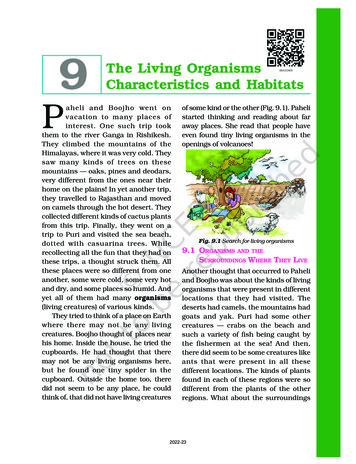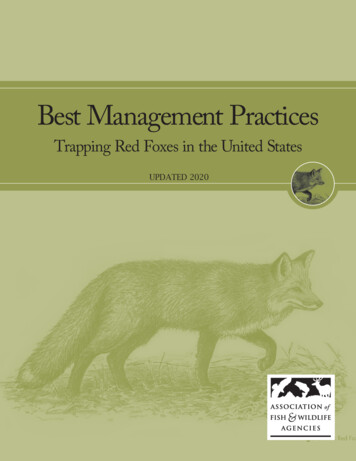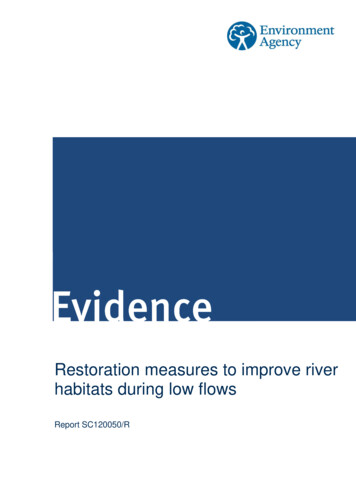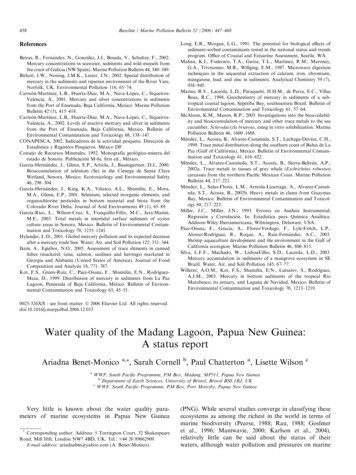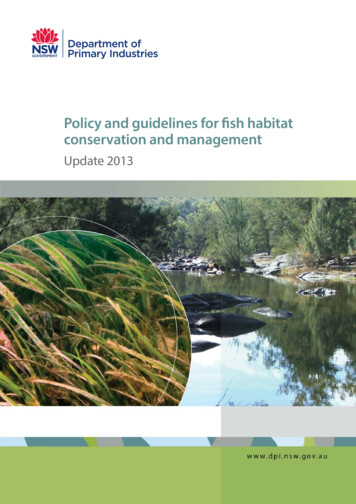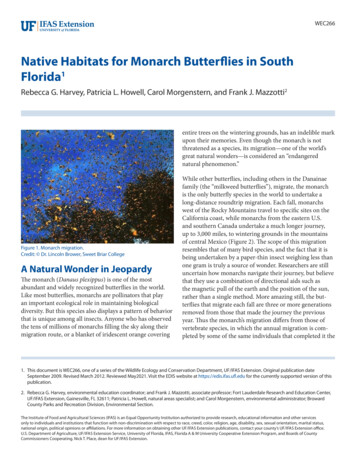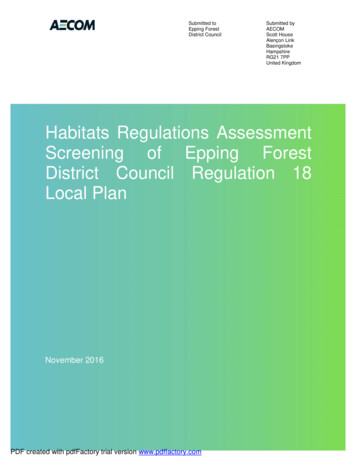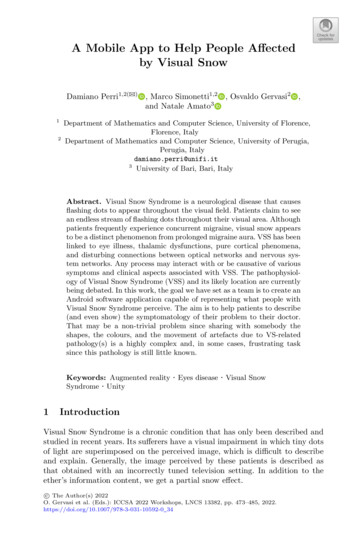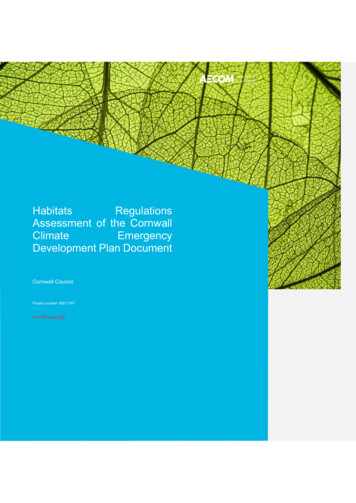
Transcription
Information Classification: CONTROLLEDHabitatsRegulationsAssessment of the CornwallClimateEmergencyDevelopment Plan DocumentCornwall CouncilProject number: 60571547June 2021July 2022
Habitats Regulations Assessment of theCornwall Climate Emergenncy DevelopmentProject number: 60571547InformationClassification: CONTROLLEDPlan DocumentQuality informationPrepared byChecked byVerified byApproved byDr Damiano WeitowitzSenior EcologistDrJamesRileyTechnical DirectorDr Max WadeTechnical DirectorDrJamesRileyTechnical DirectorRevision HistoryRevisionRevision dateDetailsNamePosition0January 2021DraftClimate JREmergency DPDHRA reportAuthorizedDr James RileyTechnicalDirector1May 2021Revised for DPD JRsubmission andto take accountofNaturalEnglandcommentsDr James RileyTechnicalDirector2June 2021Revisionsin JRresponsetoclient comments,further changesto the DPD and asecond NaturalEnglandconsultationDr James RileyTechnicalDirector3July 2022Final revisions to JRpolicywordingfollowingDPDExaminationDr James RileyTechnicalDirectorDistribution List# Hard CopiesPDF RequiredPrepared for: Cornwall CouncilAssociation / Company NameAECOM
Habitats Regulations Assessment of theCornwall Climate Emergenncy DevelopmentProject number: 60571547InformationClassification: CONTROLLEDPlan DocumentPrepared for:Cornwall CouncilPrepared by:Dr Damiano WeitowitzSenior EcologistE: damiano.weitowitz@aecom.comAECOM LimitedMidpoint, Alencon LinkBasingstokeHampshire RG21 7PPUnited KingdomT: 44(0)1256 310200aecom.com 20221 AECOM Limited. All Rights Reserved.This document has been prepared by AECOM Limited (“AECOM”) for sole use of our client (the “Client”)in accordance with generally accepted consultancy principles, the budget for fees and the terms ofreference agreed between AECOM and the Client. Any information provided by third parties andreferred to herein has not been checked or verified by AECOM, unless otherwise expressly stat ed inthe document. No third party may rely upon this document without the prior and express writtenagreement of AECOM.Prepared for: Cornwall CouncilAECOM
Habitats Regulations Assessment of theCornwall Climate Emergenncy DevelopmentProject number: 60571547InformationClassification: CONTROLLEDPlan DocumentTable of Contents1.Introduction . 7Legislation . 8Scope of the Project . 8The Layout of this Report . 9Quality Assurance . 92.Methodology . 11Introduction. 11Description of HRA Tasks . 11HRA Task 1 – Likely Significant Effects (LSE) . 11HRA Task 2 – Appropriate Assessment (AA) . 12HRA Task 3 – Avoidance and Mitigation . 12Geographical Scope of the HRA . 123.European Sites . 13Marazion Marsh SPA . 25Introduction. 25Qualifying Species . 25Conservation Objectives . 25Threats / Pressures to Site Integrity . 25Tamar Estuaries Complex SPA . 26Introduction. 26Qualifying Species . 26Conservation Objectives . 26Threats / Pressures to Site Integrity . 26Falmouth Bay to St. Austell Bay SPA . 27Introduction. 27Qualifying Species . 27Conservation Objectives . 27Threats / Pressures to Site Integrity . 284.Background to Impact Pathways . 29Wind Turbines – Impacts on SPA Species . 29Birds . 29Collision Mortality . 29Disturbance Displacement and Impacts on Flightlines . 30Hydroelectricity . 32Impacts on Marine Mammal and Fish Mobility / Migrations . 32Impacts on Water Quantity and Sedimentation . 32Impacts on Ecological Communities (e.g. Intertidal Habitats) . 33Increased Fish Mortality and Impingement . 34Visual and Noise Disturbance in SPAs, SACs and Functionally Linked Habitats . 35Construction Period . 35Birds . 35Fish / Marine Mammals . 36Loss of Functionally Linked Habitat . 37Water Quality . 38Atmospheric Pollution (via Ammonia / Nitrogen deposition) . 39Coastal Squeeze . 425.Test of Likely Significant Effects (LSEs) . 43Wind turbines – Impacts on SPA Species . 43Prepared for: Cornwall CouncilAECOM
Habitats Regulations Assessment of theCornwall Climate Emergenncy DevelopmentProject number: 60571547InformationClassification: CONTROLLEDPlan DocumentCollision mortality . 43Disturbance Displacement and Impact on Flightlines . 43Screening of DPD policies . 45Hydroelectricity Installations. 45Impacts on Fish Mobility / Migrations . 45Impacts on Water Quantity and Sedimentation . 45Impacts on Intertidal Habitats. 46Direct Impacts on Fish – Impingement and Increased Mortality . 46Screening of DPD policies . 47Visual and Noise Disturbance in SPAs, SACs and Functionally Linked Habitats . 47Wind Farm Construction Period - Birds . 47Hydroelectric Schemes Construction Period – Fish & Marine Mammals . 47Screening of DPD policies . 48Loss of Functionally Linked Habitat . 48Screening of DPD policies . 48Water Quality . 49Screening of DPD policies . 50Atmospheric Pollution (via Ammonia / Nitrogen Deposition) . 50Screening of DPD policies . 51Coastal Squeeze . 51Screening of DPD policies . 526.Appropriate Assessment . 53Wind turbines – Impacts on SPA species . 53Collision mortality . 53Relevant Mitigation . 54Disturbance Displacement and Impact on Flightlines . 55Disturbance Displacement . 55Impact on Flightlines . 56Relevant Mitigation . 56Hydroelectricity Installations – Impacts on SAC / SPA species . 57Impacts on Fish Mobility and Migrations . 57Impacts on Water Quantity and Sedimentation . 59Impacts on Intertidal Habitats. 60Increased Fish Mortality and Impingement . 61Visual and noise disturbance in SPAs, SACs and Functionally Linked Habitats . 62Wind Farm Construction Period - Birds . 62Hydroelectric Schemes Construction Period – Fish & Marine Mammals . 63Loss of Functionally Linked Habitat . 65Water Quality . 66Atmospheric Pollution (Ammonia / Nitrogen Deposition) . 68Coastal Squeeze . 697.Conclusions & Recommendations . 71Wind turbines – Impacts on SPA species . 71Collision mortality . 71Disturbance Displacement and Impacts on Flightlines . 71Hydroelectricity Installations – Impacts on SAC / SPA species . 72Impacts on Fish Mobility and Migrations . 72Impacts on Water Quantity and Sedimentation . 72Impacts on Intertidal Habitats. 72Increased Fish Mortality and Impingement . 73Visual and noise disturbance in SPAs, SACs and Functionally Linked Habitats . 73Prepared for: Cornwall CouncilAECOM
Habitats Regulations Assessment of theCornwall Climate Emergenncy DevelopmentProject number: 60571547InformationClassification: CONTROLLEDPlan DocumentWind Farm Construction Period - Birds . 73Hydroelectric Schemes Construction Period – Fish & Marine Mammals . 73Loss of Functionally Linked Habitat . 73Water Quality . 74Atmospheric Pollution (via Ammonia / Nitrogen Deposition) . 74Coastal Squeeze . 758.Main Modifications . 75Appendix A Maps . 76Appendix B Screening for Likely Significant Effects (LSEs) . 78FiguresFigure 1: The legislative basis for Appropriate Assessment . 8Figure 2: Four Stage Approach to Habitats Regulations Assessment. Source EC, 2001. . 11Figure 3: Map of sensitive bird areas in relation to onshore wind farms in England. Note that this mapis based on the highest sensitivity rating for any of the species or sites included, in each constituent 1km square. (reproduced from Bright et al., 2009). . 31Figure 4: Map showing the European sites assessed in the context of the Cornwall ClimateEmergency DPD. Note that the map includes several offshore marine European sites beyondCornwall’s boundary, linked to the DPD via impact pathways. . 76Figure 5: Map illustrating the broad areas suitable for wind turbine development, and their overlapwith the 1km disturbance displacement and 3km core foraging zones surrounding the Marazion MarshSPA and Tamar Estuaries Complex SPA. . 77TablesTable 1: Summary of European sites relevant to the Cornwall Climate Emergency DPD, including sitetype, qualifying features, threats / pressures to site integrity (as identified in Natural England’s SiteImprovement Plans) and potential impact pathways linking to the DPD. . 14Table 2: Main sources and effects of air pollutants on habitats and species . 40Table 3: Likely Significant Effects (LSEs) test for policies included in the emerging Climate EmergencyDevelopment Plan Document for Cornwall. Each policy is assessed for potential impact pathwayslinking to European sites. . 78Prepared for: Cornwall CouncilAECOM
Habitats Regulations Assessment of theCornwall Climate Emergenncy DevelopmentProject number: 60571547InformationClassification: CONTROLLEDPlan Document1. Introduction1.1AECOM was appointed by Cornwall Council (CC) to undertake a Habitats RegulationsAssessment of its Climate Emergency Development Plan Document (DPD). The objective of thisassessment was to identify any aspects of the DPD that would cause Likely Significant Effects(LSEs) on, or adverse effects on the integrity of, European sites (Special Areas of Conservation(SACs), Special Protection Areas (SPAs), candidate Special Areas of Conservation (cSACs),potential Special Protection Areas (pSPAs) and, as a matter of Government policy, Ramsar sites.The assessment is undertaken on the DPD alone and, if relevant, in-combination with other plansand projects that may have a cumulative effect. Under the Conservation of Habitats and SpeciesRegulations 2017 (as amended), an Appropriate Assessment is required where a plan or projectis likely to result in LSEs upon a European Site, either individually or ‘in combination’ with otherprojects. Should the HRA identify potential adverse effects, it also advises on appropriate policymechanisms for delivering mitigation.1.2Cornwall’s Climate Emergency DPD represents a key action of Cornwall’s Climate Change ActionPlan with the intention to facilitate a carbon-neutral Cornwall by 2030, 20 years prior to the UKcommitment. It seeks to implement a fundamental principle of the National Planning PolicyFramework (NPPF), which is to transition to a low carbon economy through encouraging energyreduction, promoting renewable energy sources and facilitating more sustainable living. The DPDcontains policy wording to encourage change in various sectors that are key to a ‘greener’economy, including energy efficiency standards, agricultural practices, retrofitting and reusingexisting buildings, and encouraging growth in sustainable energy sources. The overarchingplanning framework for Cornwall is outlined in the adopted Cornwall Local Plan (CLP); the DPDis a subordinate document to the CLP and supports its strategic policies.1.3Cornwall is an authority of 3,546km2 on the south-western tip of England. Large parts of Cornwallhave a rural character and varied scenery. The county is known for its ecological interest,comprising wild moorland landscapes and long, varied coastlines. Overall, 16 SACs lie eitherwholly or partly (e.g. the Tintagel-Marsland-Clovelly Coast SAC and the Plymouth Sound &Estuaries SAC) within Cornwall. Furthermore, three SACs lie within 10km of the authorityboundary, including the Culm Grasslands SAC, South Dartmoor Woods SAC and BlackstonePoint SAC. Most of these SACs are sensitive to atmospheric pollution (primarily in the form ofatmospheric nitrogen deposition which stems partly from combustion) and are therefore likely tobenefit from the DPD’s focus on sustainable energies. Two Cornish SPAs are designated formobile bird species (the Marazion Marsh SPA and Tamar Estuaries Complex SPA) and are thussensitive to noise disturbance and to obstruction from certain types of renewable energy scheme,especially wind farms. Cornwall also harbours two European sites (the River Camel SAC andPlymouth Sound and Estuaries SAC) that are designated for migratory fish species.Hydroelectricity schemes thus represent a potential threat to the designated species dependingon the potential of such schemes to disrupt migration pathways. Various marine sites (e.g. theFalmouth Bay to St Austell Bay SPA) also require appraisal in the context of the DPD.1.4An initial review of the DPD highlights that all its policies seek to increase sustainability and areduction in carbon emissions, since the overarching purpose of the DPD is environmentallypositive. This will clearly aid in tackling atmospheric pollution and climate change. Therefore, theDPD will be positive for many of Cornwall’s SACs and its two SPAs, comprising habitats andspecies that are directly or indirectly sensitive to atmospheric nitrogen deposition, and elevatedammonia, NOx and sulphur dioxide concentrations, of which one of the biggest sources iscombustion and industrial processes. The transition from fossil-fuelled energies to renewables isexpected to reduce overall pollutant concentrations and deposition in European sites.Notwithstanding this, renewable energies (particularly wind farms and hydroelectric schemes)and agricultural schemes (particularly intensive animal husbandry) can also be associated withnegative impacts on the environment depending on how they are designed and delivered. TheDPD supports such proposals, which are thus the principal focus of this HRA.1.41.5 The HRA was produced and submitted for Examination alongside the DPD in 2021. Thiscurrent iteration is an update to the submitted HRA to take account of changes made toPrepared for: Cornwall CouncilAECOM7
Habitats Regulations Assessment of theCornwall Climate Emergenncy DevelopmentProject number: 60571547InformationClassification: CONTROLLEDPlan Documentpolicy following Examination of the DPD as Main Modifications. The technical analysis inthe report is therefore unchanged from that in 2021. All that has changed is policy wordingparticularly in Appendix B. All changes to the report are shown as ‘track changes’ for easeof reference. Where any changes to policy wording affect the conclusions of the HRA thisis noted in the report.Legislation1.51.6 The UK left the EU on 31 January 2020 under the terms set out in the European Union(Withdrawal Agreement) Act 2020 (“the Withdrawal Act”). This established a transition period,which is currently set to end on 31 December 2020. The Withdrawal Act retains the body ofexisting EU-derived law within our domestic law. During the transition period EU law applies toand in the UK. The most recent amendments to the Habitats Regulations – the Conservation ofHabitats and Species (Amendment) (EU Exit) Regulations 2019 – make it clear that the need forHRA will continue after the end of the Transition Period. Figure 1 below sets out the legislativebasis for Appropriate Assessments.1.61.7 The HRA process applies the ‘Precautionary Principle’ 1 to European sites. Plans and projectscan only be permitted having ascertained that there will be no adverse effect on the integrity ofthe European site(s) in question. Plans and projects with predicted adverse impacts on Europeansites may still be permitted if there are no alternatives to them and there are Imperative Reasonsof Overriding Public Interest (IROPI) as to why they should go ahead. In such cases,compensation would be necessary to ensure the overall integrity of the site network.1.71.8 In order to ascertain whether or not site integrity will be affected, an Appropriate Assessmentshould be undertaken of the plan or project in question:Conservation of Habitats and Species Regulations 2017 (as amended)The Regulations state that:“A competent authority, before deciding to give any consent for a plan or project whichis likely to have a significant effect on a European site shall make an appropriateassessment of the implications for the site in view of that sites conservation objectives The authority shall agree to the plan or project only after having ascertained that it will notadversely affect the integrity of the European site”.Figure 1: The legislative basis for Appropriate Assessment1.81.9 Over time the phrase ‘Habitats Regulations Assessment’ (HRA) has come into wide currency todescribe the overall process set out in the Habitats Directive from screening through to IROPI.This has arisen in order to distinguish the process from the individual stage described in the lawas an ‘Appropriate Assessment’.1.91.10 In spring 2018 the ‘Sweetman’ European Court of Justice ruling 2 clarified that ‘mitigation’ (i.e.measures that are specifically introduced to avoid or reduce a harmful effect on a European sitethat would otherwise arise) should not be taken into account when forming a view on likelysignificant effects. Mitigation should instead only be considered at the Appropriate Assessmentstage. This HRA has been cognisant of that ruling.Scope of the Project1.101.11There is no guidance that dictates the physical scope of an HRA of a Plan documentin all circumstances. Therefore, in considering the physical scope of the assessment, AECOMwas guided primarily by the identified impact pathways (called the source-pathway-receptor1The Precautionary Principle, which is referenced in Article 191 of the Treaty on the Functioning of the European Union, hasbeen defined by the United Nations Educational, Scientific and Cultural Organisation (UNESCO, 2005) as: “When humanactivities may lead to morally unacceptable harm [to the environment] that is scientifically plausible but uncertain, actions shallbe taken to avoid or diminish that harm. The judgement of plausibility should be grounded in scientific analysis”.2People Over Wind and Sweetman v Coillte Teoranta (C-323/17)Prepared for: Cornwall CouncilAECOM8
Habitats Regulations Assessment of theCornwall Climate Emergenncy DevelopmentProject number: 60571547InformationClassification: CONTROLLEDPlan Documentmodel) rather than by arbitrary ‘zones’. Current guidance suggests that the following Europeansites be included in the scope of assessment: All sites within the boundary of Cornwall; and, Other sites shown to be linked to development within the authority boundary through aknown impact ‘pathway’ (discussed below).1.111.12Briefly defined, impact pathways are routes by which the implementation of a policywithin a Local Plan document can lead to an effect upon a European designated site. An exampleof this would be new residential development resulting in an increased population and thusincreased recreational pressure, which could then affect European sites by, for example,disturbance of wintering or breeding birds.1.121.13Guidance from the Ministry of Housing, Communities and Local Government (MHCLG)states that the HRA should be ‘proportionate to the geographical scope of the [plan policy]’ andthat ‘an AA need not be done in any more detail, or using more resources, than is useful for itspurpose’ (MHCLG, 2006, p.6). More recently, the Court of Appeal ruled that providing the Council(competent authority) was duly satisfied that proposed mitigation could be ‘achieved in practice’to satisfy that the proposed development would have no adverse effect, then this would suffice.This ruling has since been applied to a planning permission (rather than a Core Strategydocum
JR Dr James Riley Technical Director Distribution List # Hard Copies PDF Required Association / Company Name. Habitats Regulations Assessment of the Cornwall Climate Emergenncy Development Plan Document Project number: 60571547 Prepared for: Cornwall Council AECOM
